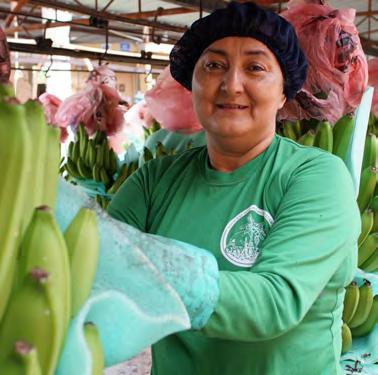
4 minute read
Market perspective: Producers’ sales in 2021
Despite the ongoing pandemic context, many Fairtrade producers achieved some recovery in 2021, reaching €190 million in Fairtrade Premium earned worldwide. However, rising farm and household expenses are still threatening farmers’ and workers’ financial security.
Bananas
Sales of Fairtrade bananas were stable, with six out of 10 Fairtrade bananas also certified organic. Fairtrade producers have been facing continuous increases in production costs, especially packing materials, fertilizers, energy, logistics and higher freight rates. Early in 2022, in the face of depressed banana prices, seven Latin American governments took the unprecedented step of calling for shared responsibility, fairer prices for farmers, and the use of the Fairtrade banana pricing methodology as a reference in the industry. The response to this advocacy will be seen early in 2023 as annual contracts are set. The top consumer markets for Fairtrade bananas in 2021 were the UK, Germany and France, with strong gains in Austria, Canada and Spain.
Flowers
Following a difficult year in 2020, Fairtrade flower producers saw sales increase by 21 percent in 2021. The pandemic influenced this as consumers shopped at supermarkets – the main source for Fairtrade flowers – more often during lockdowns. Flower farms are investing more in solar and other green technology, while a study of Kenyan flower farms found that transport by ship to Europe reduces CO2 emissions by up to 95 percent compared to air freight. Workers in East Africa, particularly Kenya and Ethiopia, grow nine out of 10 Fairtrade blooms sold around the world. The top markets for Fairtrade flowers and plants in 2021 were Germany, the UK, and Switzerland, followed closely by Finland, Sweden and Austria. Italy, France and Ireland showed particularly strong growth trends.
Coffee
Fairtrade producers’ coffee sales remained relatively stable with a slight decline of three percent, as out-of-home coffee purchases were still affected by COVID-19. Rising global market prices were largely offset by spiking costs of fertilizer and transport, which have further increased in 2022 along with the cost of living. Fairtrade’s wellrespected national Golden Cup competitions were held in 13 countries, continuing to showcase the high quality of Fairtrade coffee and attract new buyers. To support expanding markets, small-scale roasters in a growing number of countries can offer Fairtrade coffee more affordably, and coffee can now be Fairtrade certified as part of multi-ingredient products. The revised Fairtrade Coffee Standard, published in 2021, includes clearer restrictions on unfair trading practices, and new requirements on human rights and environmental assessments and actions. The top markets for Fairtrade coffee in 2021 were Germany, the UK, Canada, France and the US. Switzerland and smaller emerging markets showed double digit growth in 2021.
Cocoa
Fairtrade cocoa producers recorded significant sales growth of 37 percent in 2021. This followed contraction in 2020 due to traders selling off excess Fairtrade cocoa stock, logistical challenges caused by the pandemic, and the impact of the Fairtrade Minimum Price and Premium increase for farmers as of October 2019. The growth is attributed to continued support from commercial partners and new commercial partners choosing to buy Fairtrade. The top markets for Fairtrade cocoa products in 2021 were Germany, the US, UK, Netherlands and France. Emerging markets saw cocoa sales grow by 60 percent in 2021.
The Fairtrade Premium has helped us a lot. We have everything one needs in terms of protective equipment. We also planted some seedlings. So it has served us a lot.”
Isabel Jaramillo with banana organization Asociación Agropecuaria Las Guayas, Ecuador

Cotton
In 2021, Fairtrade cotton producers experienced an uneven pace of recovery from COVID-19. Two-thirds of all Fairtrade cotton came from India, which saw a decrease in sales, while Pakistani farmers’ sales increased by 27 percent. Fairtrade launched a pilot project in India in 2021, in which an additional ‘organic differential’ is paid in addition to the Fairtrade price for organic cotton. With support from ISEAL, Fairtrade also participated in pilot projects to test the Delta framework methodology, designed by cotton and coffee initiatives as a harmonised approach to sustainability performance reporting for agriculture. The biggest markets for Fairtrade cotton in 2021 were Germany and France, both of which showed strong growth compared to 2020.
Sugar
Fairtrade sugar sales ticked up in 2021, consistent with a pattern of fluctuation that is in part due to a bounceback from the onset of the pandemic in 2020, but also the timing of Fairtrade Premium payments to producer organizations, which in some countries fall in different reporting years. Fairtrade sugarcane producers played a key role in Belize’s adoption of a National Child Labour Policy and Strategy through 2025, thanks to their own youth-inclusive initiatives with Fairtrade’s support. Fairtrade is also conducting a number of carbon and water footprint studies with supply chains in specific origins. The UK, the US and Germany again led in retail market sales in 2021, with Finland and Italy showing strong growth.
Tea
Globally there is a downward trend in the demand for tea, possibly due to a shift to other beverages in some markets, and Fairtrade producers sales have unfortunately been no exception. Although not all retail markets saw growth in 2021, the largest markets for Fairtrade tea were the UK, Switzerland, and Netherlands. Sales growth was positive in Australia, New Zealand and Ireland, among others.
Estimated volume of the top seven products sold by Fairtrade producers in 2021
Notes
The data in this table are from the seven products that represent more than 90 percent of all Fairtrade farmers and workers. The volumes reported are of sales on Fairtrade terms regardless of ultimate market destination, and reflect the best available information at the time of publication.
The majority of Fairtrade Premium is paid to producers in US dollars although Fairtrade International reports in euros for consistency. The annual growth rate in US dollars for Fairtrade Premium earnings for the top seven products in 2021 was eight percent.








